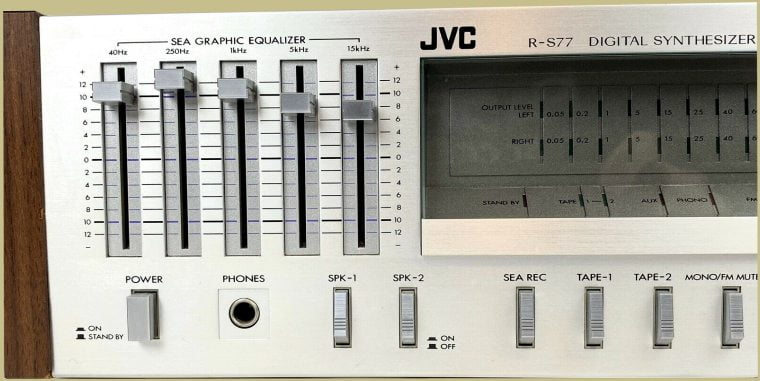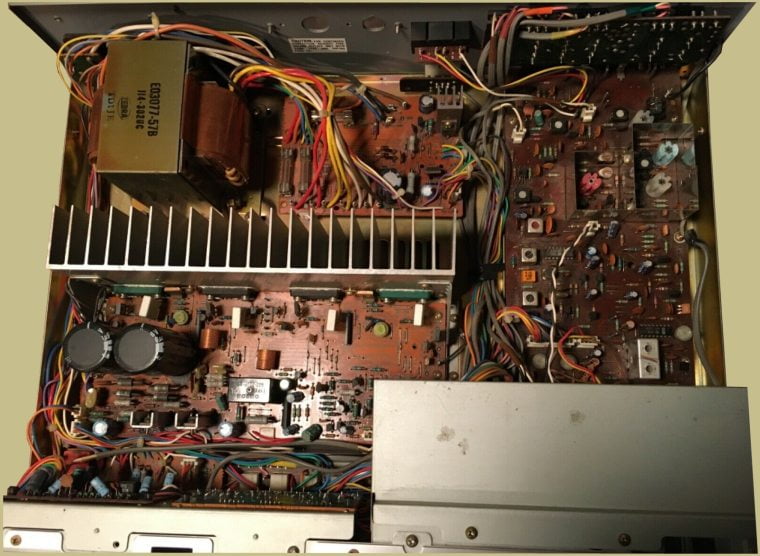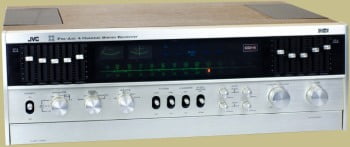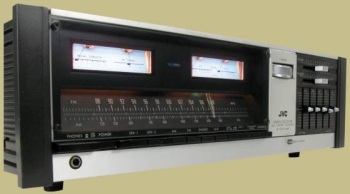
This JVC R-S77 is another transitional era receiver, produced at a time when manufacturers were moving from silver faces, wood cabinets, knobs and analog dials to digital displays, colorful LED’s, sliders and push buttons. The R-S77 was JVC’s top of the line receiver when it hit the market in 1980. JVC called it a Digital Synthesizer Stereo Receiver and slapped a Super-A logo just above the tuning display. It retailed for a somewhat hefty $560 at the time and produces 60 watts per channel into 8 ohms.

The SEA graphic equalizer was one of the big selling features. Instead of just bass and treble controls the user could adjust frequency levels via slider controls in five separate bands.
Another feature was what JVC termed Super-A. Super-A is a modified Class-AB amplifier design that attempts to eliminate crossover distortion. Other amps did this as well but JVC’s take on it was to use the special Super-A circuitry only when the signal level reached certain thresholds. It was probably mostly marketing hype as it wasn’t a true Class-A design but most owners claim that the sound is extremely clean and yet non-fatiguing at the same time. And, to be fair to JVC, the 0.005% total harmonic distortion is very good.

The R-S77 has an array of lights, push buttons and sliders. It has dual 8-LED power level indicators, a high filter switch, loudness switch, and sliding balance and volume controls.
The tuner on the R-S77 is great. It features PLL digital synthesizer design with six-station AM/FM memory presets. Tuning can be accomplished via the manual tuning buttons or through automatic scan tuning. The LED tuning display even has a dimmer which is a nice touch. There is also a push button switch for tuning to local or distant stations.

Specifications:
- AM/FM Digital Synthesizer Stereo Receiver (1980) $530
- Weight: 10.6 kg / 23 lb 5.6 oz
- Dimensions: 452 x 119 x 382 mm / 17.8 x 4.7 x 15 inches
- Outputs for 2 pair of speakers
- 5 band graphic EQ
- 2 deck tape monitoring/dubbing
- FM muting
- Aux port can be used as phone or MP3 player input
- Power output: 60 watts per channel into 8Ω (stereo)
- Frequency response: 20Hz to 20kHz
- Total harmonic distortion: 0.005%
- Input sensitivity: 2.5mV (MM), 180mV (line)
- Signal to noise ratio: 77dB (MM), 98dB (line)
JVC’s R-S77 does have some weak points. Aesthetically the case leaves a little to be desired. It is a metal case with vinyl covered, press board side panels that are a little cheezy for a TOTL receiver. The ALPS 4PDT power switch tends to fail over time and it is hard to find replacements. The phono section is decent but not fantastic. The unit also tends to run very hot which can cause some issues with solder joints over the years. You can see that JVC tried to mitigate the heat build up with a huge heat sink in the middle of the unit.
A commenter below brought up some relevant and useful points about the R-S77:
- Not all contacts on the ALPS 4PDT power switch are used and it can be replaced with the more easily found ALPS 3PDT with absolutely no loss of function.
- Recommend re-lubricating the slider controls rather than cleaning them. (Fader_lube by DeOxit is one option that works well.)
- If needed, re-solder the joints on the SEA Graphic Equalizer board. In my opinion, this is the magic bullet to get the JVC RS-77 back to top performance.

Some love the look of the JVC R-S77 while others hate it but it’s hard to argue with its performance. It’s a sleeper among the vintage audio community which means you can pick one up cheap. Just check the power switch and digital displays to make sure they function properly and be prepared to clean the slider controls as they can get dirty over time. But, that’s true with a lot of vintage audio equipment. Overall the build quality and performance of the JVC R-S77 is very good.


Great Documentation on the JVC RS-77. Well Done. Very Thorough.
I have fully restored two units. A few comments:
1._Not all contacts on the ALPS 4PDT power switch are used.
It can be replaced with the more easily found ALPS 3PDT with absolutely no loss of function. 2._Recommend re-lubricating the slider controls rather than cleaning them. (Fader_lube by DeOxit is one option that works well.) 3.) If needed, re-solder the joints on the SEA Graphic Equalizer board. In my opinion, this is the magic bullet to get the JVC RS-77 back to top performance.
Thanks! I added your comments to the body of the post.